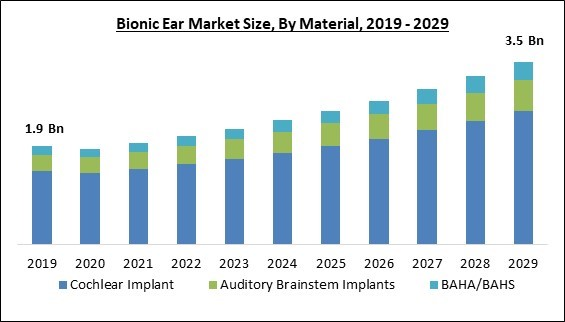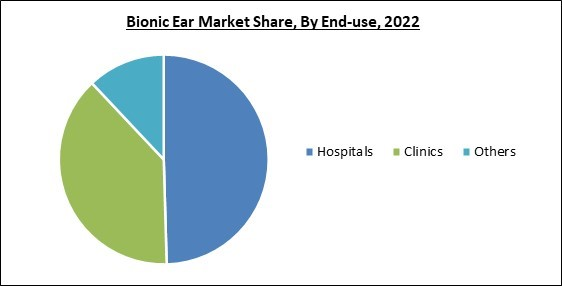Cochlear implant is the most used type of Bionic Ear because of an increase in cochlear implantation procedures and market penetration. Hence, Cochlear Implant is expected to capture more than 70% share of the market by 2019. By 2050, 1 in 4 individuals, or over 2.5 billion people, will have some degree of hearing loss, according to the WHO. If no action is taken, over 700 million individuals would need rehabilitation services, ear and hearing treatment, and other health care facilities. A hearing loss handicap affected the quality of life of 466 million individuals in 2019, or about 5% of the world's population. This included 34 million children and 432 million adults. These people predominantly reside in middle- and low-income countries.
In addition, untreated hearing loss costs the global economy USD 750 billion. In general, it is advised that public health initiatives can prevent the majority of hearing loss conditions. Some of the factors impacting the market rising proportion of aging people globally, increasing R&D expenditures to create the most advanced bionic hearing aids, and prioritization of cost containment by healthcare institutions.
The World Health Organization (WHO) reports that the percentage and total number of people in the population who are 60 years of age and older is rising. It was noted that 1 billion persons aged 60 and over lived in the world in 2019. By 2030 and 2050, this number is expected to increase to 1.4 billion and 2.1 billion, respectively. In particular, in developing countries, this increase will pick up speed in the future years. The demand for advanced hearing-aiding devices is increasing as the older population grows. The market is witnessing a worldwide explosion of prototypes, new research, and gadgets, as is the case with practically every element of human bionics. This has led to the development of innovative technologies pertaining to bionic hearing, like augmented bionics' non-surgical bionic ear and haptic devices. The augmented bionics' non-surgical bionic ear is currently in the early stages of development.
However, prioritization can occur through many methods, including bidding, pricing controls, tender processes, competitive rates, comparative effectiveness analyses of pharmaceuticals, managed-care agreements, insurance & payment policies, and technology evaluations are used. There is always a concern that these devices will malfunction because of their complicated structures and layers of delicate electronic parts. This market is associated with expensive medical and device costs. Furthermore, the sales of bionic ear devices were impacted by the uncertain economy and declining consumer expenditure. The healthcare sector was negatively impacted by the COVID-19 pandemic. The number of patients who required urgent care was overwhelming in hospitals worldwide, and many healthcare institutions reached their maximum capacity. Therefore, the pandemic had a negative impact on the market.
End-use Outlook
On the basis of end-use, the market is classified into hospitals, clinics, and others. The clinics segment recorded a significant revenue share in the market in 2022. For some people with advanced sensorineural hearing loss (SNHL), numerous clinics now offer cochlear implantation operations to restore auditory functions. The incidence of hearing loss and the rising number of ENT (ear, nose, and throat) clinics with modern equipment are accelerating the segment's rise. Additionally, the number of ENTs has been increasing continuously, reaching even the remotest regions.Type Outlook
Based on type, the market is characterized into cochlear implant, auditory brainstem implants, and BAHA/BAHS. The cochlear implant segment garnered the highest revenue share in the market in 2022. The quality of life and hearing abilities of thousands of people worldwide have been restored because of significant breakthroughs in cochlear implants. These are the sole medical procedures that can partially restore hearing to a deaf patient by electrically stimulating the remaining auditory nerve. For those whose severe hearing loss is caused by inner ear damage and hearing aid use is no longer effective, it may be a viable choice.Regional Outlook
Region wise, the market is analyzed across North America, Europe, Asia Pacific, and LAMEA. The Europe segment witnessed the maximum revenue share in the market in 2022. The region's high prevalence of patients with hearing loss, particularly among the senior population, is a major factor in the market growth. The development of the industry is also being aided by improvements in bionic ear technology, a rise in the prevalence of cochlear implants in both adults and children and greater knowledge of available remedies for hearing loss.The market research report covers the analysis of key stake holders of the market. Key companies profiled in the report include Cochlear Ltd., MED-EL GmbH, Sonova Holding AG, Zhejiang Uniview Technologies Co., Ltd. (Hangzhou Jiaozhi Technology Co., Ltd.), Boston Scientific Corporation, Medtronic PLC, Amplifon S.P.A., Starkey laboratories, Inc., GN Store Nord A/S (GN Hearing A/S), and WS Audiology A/S.
Scope of the Study
By End-use
- Hospitals
- Clinics
- Others
By Type
- Cochlear Implant
- Auditory Brainstem Implants
- BAHA/BAHS
By Geography
- North America
- US
- Canada
- Mexico
- Rest of North America
- Europe
- Germany
- UK
- France
- Russia
- Spain
- Italy
- Rest of Europe
- Asia Pacific
- China
- Japan
- India
- South Korea
- Singapore
- Malaysia
- Rest of Asia Pacific
- LAMEA
- Brazil
- Argentina
- UAE
- Saudi Arabia
- South Africa
- Nigeria
- Rest of LAMEA
Key Market Players
List of Companies Profiled in the Report:
- Cochlear Ltd.
- MED-EL GmbH
- Sonova Holding AG
- Zhejiang Uniview Technologies Co., Ltd. (Hangzhou Jiaozhi Technology Co., Ltd.)
- Boston Scientific Corporation
- Medtronic PLC
- Amplifon S.P.A.
- Starkey laboratories, Inc.
- GN Store Nord A/S (GN Hearing A/S)
- WS Audiology A/S
Unique Offerings
- Exhaustive coverage
- The highest number of Market tables and figures
- Subscription-based model available
- Guaranteed best price
- Assured post sales research support with 10% customization free
Table of Contents
Companies Mentioned
- Cochlear Ltd.
- MED-EL GmbH
- Sonova Holding AG
- Zhejiang Uniview Technologies Co., Ltd. (Hangzhou Jiaozhi Technology Co., Ltd.)
- Boston Scientific Corporation
- Medtronic PLC
- Amplifon S.P.A.
- Starkey laboratories, Inc.
- GN Store Nord A/S (GN Hearing A/S)
- WS Audiology A/S










